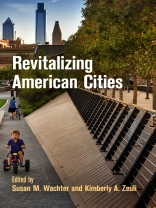Small and midsized cities played a key role in the Industrial Revolution in the United States as hubs for the shipping, warehousing, and distribution of manufactured products. But as the twentieth century brought cheaper transportation and faster communication, these cities were hit hard by population losses and economic decline. In the twenty-first century, many former industrial hubs—from Springfield to Wichita, from Providence to Columbus—are finding pathways to reinvention. With innovative urban policies and design, once-declining cities are becoming the unlikely pioneers of postindustrial urban revitalization.
Revitalizing American Cities explores the historical, regional, and political factors that have allowed some industrial cities to regain their footing in a changing economy. The volume discusses national patterns and drivers of growth and decline, presents case studies and comparative analyses of decline and renewal, considers approaches to the problems that accompany the vacant land and blight common to many of the country’s declining cities, and examines tactics that cities can use to prosper in a changing economy. Featuring contributions from scholars and experts of urban planning, economic development, public policy, and education, Revitalizing American Cities provides a detailed, illuminating look at past and possible reinventions of resilient American cities.
Contributors: Frank S. Alexander, Eugenie L. Birch, Paul C. Brophy, Steven Cochrane, Gilles Duranton, Sean Ellis, Kyle Fee, Edward Glaeser, Daniel Hartley, Yolanda K. Kodrzycki, Sophia Koropeckyj, Alan Mallach, Ana Patricia Muñoz, Jeremy Nowak, Laura W. Perna, Aaron Smith, Catherine Tumber, Susan M. Wachter, Kimberly A. Zeuli.
Table des matières
Introduction
PART I. CITY DECLINE AND REVIVAL
Chapter 1. The Historical Vitality of Cities
—Edward Glaeser
Chapter 2. The Growth of Metropolitan Areas in the United States
—Gilles Duranton
Chapter 3. The Relationship Between City Center Density and Urban Growth or Decline
—Kyle Fee and Daniel Hartley
Chapter 4. Central Cities and Metropolitan Areas: Manufacturing and Nonmanufacturing Employment as Drivers of Growth
—Steven Cochrane, Sophia Koropeckyj, Aaron Smith, and Sean Ellis
PART II. DISCOVERING RESILIENCE
Chapter 5. Lessons from Resurgent Mid-Sized Manufacturing Cities
—Yolanda K. Kodrzycki and Ana Patricia Muñoz
Chapter 6. Revitalizing Small Cities: A Comparative Case Study of Two Southern Mill Towns
—Kimberly Zeuli
Chapter 7. Parallel Histories, Diverging Trajectories: Resilience in Small Industrial Cities
—Alan Mallach
PART III. LAND AND NEIGHBORHOOD POLICY
Chapter 8. A Market-Oriented Approach to Neighborhoods
—Paul C. Brophy
Chapter 9. Transformation Is Messy Work: The Complex Challenge of Spatial Reconfiguration in America’s Legacy Cities
—Alan Mallach
Chapter 10. Tactical Options for Stable Properties
—Frank S. Alexander
PART IV. THE NEW ECONOMY AND CITIES
Chapter 11. Anchor Institutions in the Northeast Megaregion: An Important but Not Fully Realized Resource
—Eugenie L. Birch
Chapter 12. Fields, Factories, and Workshops: Green Economic Development on the Smaller-Metro Scale
—Catherine Tumber
Chapter 13. Promoting Workforce Readiness for Urban Growth
—Laura W. Perna
Afterword
—Jeremy Nowak
Notes
List of Contributors
Bibliography
Index
Acknowledgments
A propos de l’auteur
Susan M. Wachter is the Albert Sussman Professor of Real Estate and Professor of Finance, The Wharton School; Professor of City and Regional Planning, School of Design; and Co-Director, Penn Institute for Urban Research, at the University of Pennsylvania. Kimberly A. Zeuli is Senior Vice President and Director of Research and Advisory Services for the Initiative for a Competitive Inner City. She has held faculty positions at the University of Kentucky and the University of Wisconsin-Madison, and was formerly Vice President of Community Development for the Federal Reserve Bank of Richmond.












